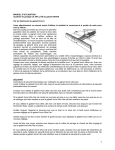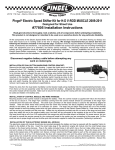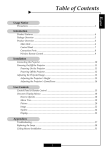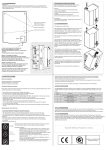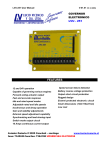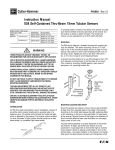Download IQ Analyzer
Transcript
Cutler-Hammer IQ Analyzer START QUICKSTART GUIDE CONTENTS Introduction 4 Mounting 9 Wiring 10 Programming 12 Troubleshooting 19 IMPORTANT NOTICE Use this Guide to begin performing basic metering functions quickly, without reviewing complete instructions provided in the User’s Manual. To more fully understand the wide array of features offered by your IQ Analyzer, it is strongly recommended that operators read the User’s Manual. Following initial power-up of the IQ Analyzer, the displayed “Meter Menu” values may not be what is anticipated for your specific system. The unit must first be programmed with “General Setup” information relating to your electrical system. For additional information or technical assistance, contact: A D VANCED PRODUCT SUPPORT CENTER 1-800-809-2772 www.cutlerhammer.eaton.com 3 Introduction Operator Panel (USER’S MANUAL SECTIONS 1&2) The IQ Analyzer is a compact, panel mounted, micro-processor based device for users who want to monitor all aspects of their electrical distribution system. It has been engineered to provide comprehensive metering, power quality analysis, remote input monitoring, control relaying, analog inputs/outputs and communications capabilities. It will replace dozens of existing individual meters, recorders, and relays. The IQ Analyzer displays a comprehensive list of metered parameters, historical values, harmonic profiles, peak demands and alarm data. Custom screens may be easily programmed to conveniently view parameter groupings, or to concurrently observe relationships as system conditions change. Information display options and device programming are accessible through a communications port via IMPACC (Integrated Monitoring Protection and Control Communications), or directly at the Operator Panel using Meter Menu and Function Keys. The IQ Analyzer directly monitors 3-phase lines to 600 Vac without the need for external potential transformers. Above 600 Vac, external transformers are required. The device complies with rigid ANSI C12.16 Class 10 revenue meter accuracy standards, and provides true rms readings through the 50th harmonic. Accuracy is maintained in applications with high distortion levels, including systems exhibiting 3.0 Crest Factor. (USER’S MANUAL SECTION 3) Function LEDs Display Window (F1-F4) Previous Level Home Function PBs Meter Menu Up/Down PBs Program PB Help PB Push Buttons (PBs) (USER’S MANUAL SECTIONS 3&4) Up/Down: Maneuver through metered values in Display Mode. Home: Return to Display Mode from other modes. Toggle between Current and Demand in Meter Menu. F1-F4: Used to enter analysis modes. Used to maneuver in program, analysis and reset modes. Previous Level: Moves up one level in hierarchy (e.g., in Program mode from PGM/GEN/TYPE to PGM/GEN). Reset: Enter/Exit Reset mode. Program: Enter/Exit Program mode. Help: Enter/Exit Help menu. 5 Modes of Operation Displayed Information Display Type Comments Current • Phase A, B, C, Average • Neutral • Ground (separate CT inputs for each) Voltage • Phase A-B, B-C, C-A, Average • Phase A-N, B-N, C-N, Average • Neutral - Ground Power • System1 and Phase A, B, C • Real (Watts) • Reactive (vars) • Apparent (VA) Energy • Forward, Reverse, Net • Real (kWh) • Reactive (kvarh) • Apparent (kVAh - Net only) Demand • System Current (A) • System Real Power (kW) • System Reactive Power (kvar) • System Apparent Power (kVA) Power Factor •System and Phase A, B, C •Displacement2 •Apparent3 Frequency •Hz •Time •Date % THD Using this password protected mode, the operator can reset or clear certain items such as Min/Max values, Alarm Triggers, Relays and Peak Demand Values. •Currents Phase A, B, C Neutral •Voltages Phase A-B, B-C, C-A Phase A-N, B-N, C-N Distortion Factor •K-Factor4 (of Event) • CBEMA Derating Factor5 (THDF) •Crest Factor6 Help Mode: Custom •Discrete Input and Output Status •Analog Input Reading •User can program two screens to display any combination of seven Meter Menu parameters per screen via the Custom Screens option under Display Manager. (PGM/DISPMGR/CUST) Display Mode: (USER’S MANUAL SECTIONS 5-2) The IQ Analyzer monitors and displays a comprehensive list of metered parameters. The Meter Menu provides easy access (using Up/Down PBs) to the most commonly used metered parameters: Current Voltage Power (Watts) Power (Vars) Power (VA) Energy Demand Power Factor Frequency %THD Distortion Factor Custom Several parameters will require multiple screens for complete display of all available information. Up/Down will toggle through all displays. Analysis Modes: (USER’S MANUAL SECTION 5-7) Analysis screens show detailed system information relative to the selected category. All historical and event information is accessed in the analysis modes. Trend Analysis Event Analysis Harmonic Analysis Demand Analysis Program Mode: (USER’S MANUAL SECTION 5-4) This password protected mode is used to configure the Unit. Use Program Mode to specify General Setup Settings and for advanced features. Reset Mode: (USER’S MANUAL SECTION 5-10) (USER’S MANUAL SECTION 5-3) The IQ Analyzer displays various Help screens and useful information relating to device operation, programming and troubleshooting. Communications (USER’S MANUAL SECTIONS 5-8) The IQ Analyzer is an IMPACC (Integrated Monitoring Protection and Control Communications) compatible device. It can be remotely monitored, controlled and programmed when equipped with the communications option. The small, addressable communications module (IPONI), is mounted to the back of the IQ Analyzer. 1 Line to neutral values do not apply for 3-wire system, use sys- tem values. 2 Fundamental watts to VA. 3 Total rms watts to VA. 4 K-Factor: A derating factor that is essentially the sum of the squares of individual harmonic currents times the squares of their harmonic number (i.e., multiples of fundamental). One for each current is displayed with largest recorded in Event metered data. 5 CBEMA Factor: A transformer harmonic derating factor defined as a pure sine wave’s crest factor (1.414) divided by the measured crest factor. 6 Crest Factor: The ratio of peak current to rms current. 7 General Mounting (USER’S MANUAL SECTIONS 5-1) When the IQ Analyzer is initially powered up, it is in Display Mode. The “Normal LED” will blink green and the “Current LED” will glow red. The display will show phases A, B and C currents in amperes for the system being monitored. IA= IB= IC= 100.0 99.0 97.0 AMPERES TRND EVNT HARM DEMD (USER’S MANUAL SECTIONS 4-2) The IQ Analyzer is typically mounted on an enclosure door. This installation makes it necessary to prepare a cutout into which the device will be placed. Top, bottom and two center side holes are used to mount the unit. A flange mounting option and separate NEMA 12/3R enclosure are available. Contact your local distributor or sales office. Initial Meter Menu Current Screen The Up and Down pushbuttons (PBs) provide fast access to other Meter Menu parameters such as those outlined in the table. The Function pushbuttons (F1-F4) access TRND, EVNT, HARM and DEMD from the Display Mode. These are Analysis Modes for Trend, Event, Harmonic and Demand information. Note on Sign Convention (USER’S MANUAL SECTIONS 5-22) As a factory default, lagging vars and power factor are represented as negative values at the load. This is a negative sign convention consistent with P=VI. The alternative is a power engineering convention which uses P=VI such that consumption of power is positive. This sign convention can be changed in the Program Mode under Power/ Energy Options in General Setup. Changing this setting will have no effect on the unsigned “LEADING KVAR-HR” and “LAGGING KVAR-HR” energy readings. However, the “NET KVAR-HR” energy will begin counting in the opposite direction. FLUSH MOUNT DRILLING PATTERN Manual Capture (USER’S MANUAL SECTIONS 5-7.2.5.12) Capture and store system values for analysis and to aid in verifying proper operation of the IQ Analyzer by using Manual Capture. Enter the Harmonic Analysis Mode from Display Mode using the F3 Function PB. In the Harmonic Analysis Mode, the unit captures new system measurements when the F4 pushbutton (NEW) is pressed twice. (F3, F4, F4) NOTE: For proper operation, an Event Trigger must be set to Manual Capture. This can be done in the Event Triggers section of the Program Mode. FLANGE MOUNT DRILLING PATTERN 9 Wiring (USER’S MANUAL SECTIONS 4-3) Wiring installation for the IQ Analyzer must follow a suitable Wiring Plan Drawing and conform to applicable Federal, State and Local codes. Wires to the terminal blocks must not be larger than AWG No. 14. Larger wire sizes may be used on the CT connections when using appropriate ring terminals. The following two figures show typical wiring diagrams. Additional wiring diagrams are shown in the User’s Manual. WARNING ! Wiring procedures must be performed only by qualified personnel who are familiar with the IQ Analyzer and its associated electrical equipment. Ensure that incoming ac power (or foreign power) sources are turned off and locked out prior to performing any electrical work. Failure to do so may result in serious injury or death, or equipment damage. The only exception is when connecting/ disconnecting ribbon cables at J2 or J3. 11 Programming Quick Start Procedure (USER’S MANUAL SECTIONS 4-5) During initial setup of your IQ Analyzer, use Steps 1 - 5 below after the IQ Analyzer has been mounted and wired using Sections 4-2 and 4-3, along with Figures 4-9 to 4-34 of the User’s Manual as a reference. STEP #1: Complete the General Setup Settings Worksheet. This will require an understanding of the electrical system configuration and transformer ratios. STEP #2: Enter the Program Mode of the IQ Analyzer. If this is an initial startup, use factory default passwords (10000 or 44444). (Program, F2, F4) STEP #3: Enter General Setup Settings using the F1-F4 PBs from the information on page 13. (An example is shown on the following pages.) STEP #4: Examine, understand and verify Metered Values. Ensure display matches your system. STEP #5: Troubleshoot problems. Use the guide provided, the Help Mode and/or the User’s Manual as a reference in troubleshooting. General Setup Settings Worksheet Type of system (select one) ❏ 3 Phase/4 Wire ❏ 3 Phase/3 Wire ❏ 1 Phase/3 Wire ❏ 1 Phase/2 Wire Phase Rotation (if Step 1 was 3 Phase, select one) ❏ ABC Rotation ❏ CBA Rotation Choose Frequency (select one) ❏ 25Hz ❏ 40Hz ❏ 50Hz ❏ 60Hz Incoming Line-to-Line Voltage Enter from 100-600 Vac __ __ __ PT Primary Rating (120 volt secondary) Enter from 120-500,000 volts __ __ __ , __ __ __ CT Primary Rating (5A secondary) Enter from 5-10,000A __ __ , __ __ __ GND CT Primary Rating (5A secondary) Enter from 5-10,000A __ __ , __ __ __ Programming Options (select one) ❏ Faceplate Only ❏ Input3 Key Only ❏ Faceplate & IMPACC (recommended) ❏ Input3 Key & IMPACC Energy Resolution for Wh, varh, & VAh (select one) ❏ Kilowatt-hours ❏ Megawatt-hours Var Sign Convention (select one) ❏ Lagging vars & PF negative at load ❏ Lagging vars & PF positive at load Date and Time Enter date and time if required __________________ Change Password Enter new 5 digit password if required __ __ __ __ __ 13 Programming Example (USER’S MANUAL SECTION 6) Meter a typical load on a 480 volt, 3 phase 3 wire (ABC phase rotation), 60Hz system with 1200/5 CTs, 50/5 ground CTs and no PTs. (Assume Kilowatt-hour energy resolution, and lagging vars & Power Factor negative at load.) NOTE: The IQ Analyzer must be programmed to a PT ratio of 120/120 or unity for the IQ Analyzer to recognize there are no PTs. From Main Menu Press and Release Program PB Top Level Entry Screen Displayed Press Up (F2), then Enter (F4) to input default password 10000 Incorrect Password Exits Program Mode Automatically Program Mode Top Level Menu Displayed General Setup Blinking Press and Release Select (F1) PB Type of System Blinking Press and Release Select (F1) PB Choose Type of System with Parameters Displayed Use F1-F3 PBs to Move an Select 3 Phase/3 Wire Phase Rotation with Parameters Displayed PGM-MAIN LAST PROGRAMMED: 6/11/97 11:48:07A INCOM ADDR:000 SOFTWARE VER. 1.14 ENTER PASSWORD:00000 (00000=VIEW ONLY PW) --> UP DOWN ENTER PGM CHOOSE CATEGORY: GENERAL SETUP ANALOG INPUTS ANALOG OUTPUTS DISCRETE INPUTS EVENT TRIGGERS SEL UP DOWN ENTER PGM/GEN SELECT PARAMETER: TYPE OF SYSTEM FREQUENCY INCOMING L-L VOLTAGE PT PRIMARY RATING CT PRIMARY RATING SEL UP DOWN PGDN PGM/GEN/TYPE 3 PHASE/4 WIRE *3 PHASE/3 WIRE SINGLE PHASE/3 WIRE SINGLE PHASE/2 WIRE Use (F2) or (F3) PBs to Move to Incoming Line-Line Voltage Press and Release Select (F1) PB L-L Voltage Rating with 3 Digits Displayed Use F1-F4 PBs to Establish and Enter 480 Volts Incoming L-L Voltage Blinking Use F2-F4 PBs to Move to PT Primary Rating PT Primary Rating Blinking Press and Release Select (F1) PB PT Primary Rating with 6 Digits Displayed Use F1-F4 PBs to Establish and Enter 120 Volts PT Primary Rating Blinking Use F2-F4 PBs to Move to CT Primary Rating CT Primary Rating Blinking Press and Release Select (F1) PB CT Primary Rating with 5 Digits Displayed SEL UP DOWN PGM/GEN/TYPE/3PH3W *ABC - PHASE ROTATION CBA - PHASE ROTATION Incoming L-L Voltage Blinking Use F1-F4 PBs to Establish and Enter 1200 A CT Primary Rating Blinking Use F2-F4 PBs to move to GND CT Primary Rating GND CT Primary Rating Blinking Press and Release Select (F1) PB GND CT Primary Rating with 5 Digits Displayed Use F1-F4 PBs to Establish and Enter 50 A GND CT Primary Rating Blinking PGM/GEN/INVOLT INCOMING L-L VOLTAGE APPLIED TO VOLTAGE INPUT TERMINALS A,B, C, N OF IQ ANALYZER (100 TO 600 VAC): 480 --> UP DOWN ENTER PGM/GEN/PT PT PRIMARY L-L RATING 120 TO 500,000 V (SEE USER’S MANUAL IF NOT USING 120V SECONDARY PTS) 000120:120 --> UP DOWN ENTER PGM/GEN/CT CURRENT TRANSFORMER PRIMARY RATING: 5 TO 10,OOO AMPS (MUST BE 5 AMP SECONDARY CT) 01200:5 --> UP DOWN ENTER UP DOWN ENTER Use F2-F4 PBs to Move and Enter ”ABC” Type of System Blinking Use (F2) or (F3) PBs to Move to Frequency Frequency Blinking Press and Release Select (F1) PB Frequency Choices Displayed Use F2-F4 PBs to Move to and Enter 60Hz Type of System Blinking continued on next page PGM/GEN SELECT PARAMETER: TYPE OF SYSTEM FREQUENCY INCOMING L-L VOLTAGE PT PRIMARY RATING CT PRIMARY RATING SEL UP DOWN PGDN PGM/GEN/FREQ 25 HZ 40 HZ 50 HZ * 60 HZ UP DOWN ENTER PGM/GEN SELECT PARAMETER: TYPE OF SYSTEM FREQUENCY INCOMING L-L VOLTAGE PT PRIMARY RATING CT PRIMARY RATING SEL UP DOWN PGDN Press Program PB to exit Program Mode PGM/GEN SELECT PARAMETER: FREQUENCY INCOMING L-L VOLTAGE PT PRIMARY RATING CT PRIMARY RATING GND CT PRIMARY RATING SEL UP DOWN PGDN PGM/GEN/GCT GND CURR TRANSFORMER PRIMARY RATING: 5 TO 10,000 AMPS (MUST BE 5 AMP SECONDARY CT) 00050:5 --> UP DOWN ENTER PGM/GEN SELECT PARAMETER: FREQUENCY INCOMING L-L VOLTAGE PT PRIMARY RATING CT PRIMARY RATING GND CT PRIMARY RATING SEL UP DOWN PGDN 15 Time/Date Programming Example From Main Menu Press and Release Program PB Use F1-F3 PBs to Move and Select Parameter to Change Top Level Entry Screen Displayed Parameter Digit Blinking Password Programming Example From Main Menu Press and Release Program PB Use F1-F4 PBs to Move and Select Change Password Top Level Entry Screen Displayed 5 Digit Password Displayed Press Up (F2), then Enter (F4) to input default password 10000 Use F1-F4 PBs to Establish and Enter New Password Press Up (F2), then Enter (F4) to input default password 10000 Use F1-F4 PBs to Establish and Enter Desired Data Incorrect Password Exits Program Mode Automatically Parameter Blinking Incorrect Password Exits Program Mode Automatically Press Program PB to Exit Program Mode Program Mode Top Level Menu Displayed Program Mode Top Level Menu Displayed General Setup Blinking Press and Release Select (F1) PB Type of System Blinking Changed Password Blinking Press Program PB to Exit Program Mode General Setup Blinking Press and Release Select (F1) PB Type of System Blinking Use F1-F4 PBs to Move and Select Change Date/Time Month Blinking 17 Troubleshooting oubleshooting (USER’S MANUAL SECTIONS 7) ymptom Operator Panel icator LED’s off. Probable Cause Possible Solutions(s) Line voltage level is deficient. • Locate cause of deficiency in ac line. • Locate deficiency in the ac control power line. • Verify that the ac line (and/or PTs) are wired properly. • Verify line voltage with multimeter. Check power module fuse(s) on affected phase(s). These are located just above voltage inputs (behind the cover of power module). Reseat or replace fuse(s) as necessary.1 Separate source control power is deficient. ac line connections (or optional external PTs) are not properly wired. Blown or loose fuse(s). ne or more voltge phases read ncorrectly. Blown or loose fuse(s). Incorrect voltage settings. ower parameters Watt, var, VA, ower Factor) ead incorrectly. Phasing for voltage and current is mismatched. CT polarity is reversed. ncorrect readings n one or more urrents. Incorrect current transformer ratio setting. •Verify line voltage with multimeter. Check power module fuse(s) on affected phase(s) located just above the voltage inputs behind the cover of power module. Reseat or replace fuse(s) as necessary. 1 • Verify correct settings programmed in the IQ Analyzer for system type,L-L voltage and PT rating. • Capture an event and compare phase angles of Va, Vb, Vc, Ia, Ib, Ic to detect possible wiring error(s). • Verify connections per wiring diagrams. • Reverse CT leads. Verify proper wiring and grounding. • Verify incoming current using a separate ammeter. • Verify proper CT ratio settings. • Check CT wiring and grounding. Power Module Fuse: Buss KTK-R-3/4 or equivalent (3/4 amp). 18 (USER’S MANUAL SECTIONS 7) Unit displays: “Hardware Failure” “Register Failure” “Multiply Failure” “Divide Failure” “Logic Failure” “Add/Subtract Failure” Possible IQ Analyzer hardware failure. •Reboot Unit by mometarily removing power cable at connector J2. •Replace Unit. Unit displays: “Internal RAM Error” “External RAM Error” “External ROM Error” IQ Analyzer hardware error. •Reboot Unit. •Replace Unit. Unit displays: “Reverse Sequence” IQ Analyzer has detected phasing difference between programmed setpoint and actual system parameters. •Verify actual system phasing. Capture an event and compare phase angles of Va, Vb, Vc, Ia, Ib, Ic to detect possible wiring error(s). • Verify that IQ Analyzer setpoint matches actual system phasing. • Verify IQ Analyzer connections. Unit fails to capture Harmonic Data when Manual Capture is pressed. No manual capture event trigger has been programmed. • Enter Program Mode and set up an Event Trigger for Manual Capture. Unit fails to communicate over IMPACC network. Wrong or conflicting address set on IPONI. • Check that IPONI has a unique address on the system and that software is addressing proper unit. • Check input/output fuse adjacent to IQ Analyzer communication connector. Replace if necessary.1 • Verify wiring is in conformance with IMPACC wiring rules. Blown fuse on IQ Analyzer. Communications wiring error. IPONI failure. Display goes blank after several minutes. Display Manager Screen Saver Option is set to blank rather than dim. • Press any pushbutton to activate display. • Program longer timeout in Meter Menu Return Time in Display Manger. Unit setpoints unchanged upon exiting program mode. Unit was in View-Only mode using password (00000). • Re-enter program setpoints using proper password. Customer established or factory default (44444 or 10000). 1 I/O Fuse: Littlefuse Plug-in Microfuse, Catalog #273.250, 0.25A, 125V or equivalent. 19 Cutler-Hammer For additional information or technical assistance, contact: ADVANCED PRODUCT SUPPORT CENTER 1-800-809-2772 www.cutlerhammer.eaton.com












